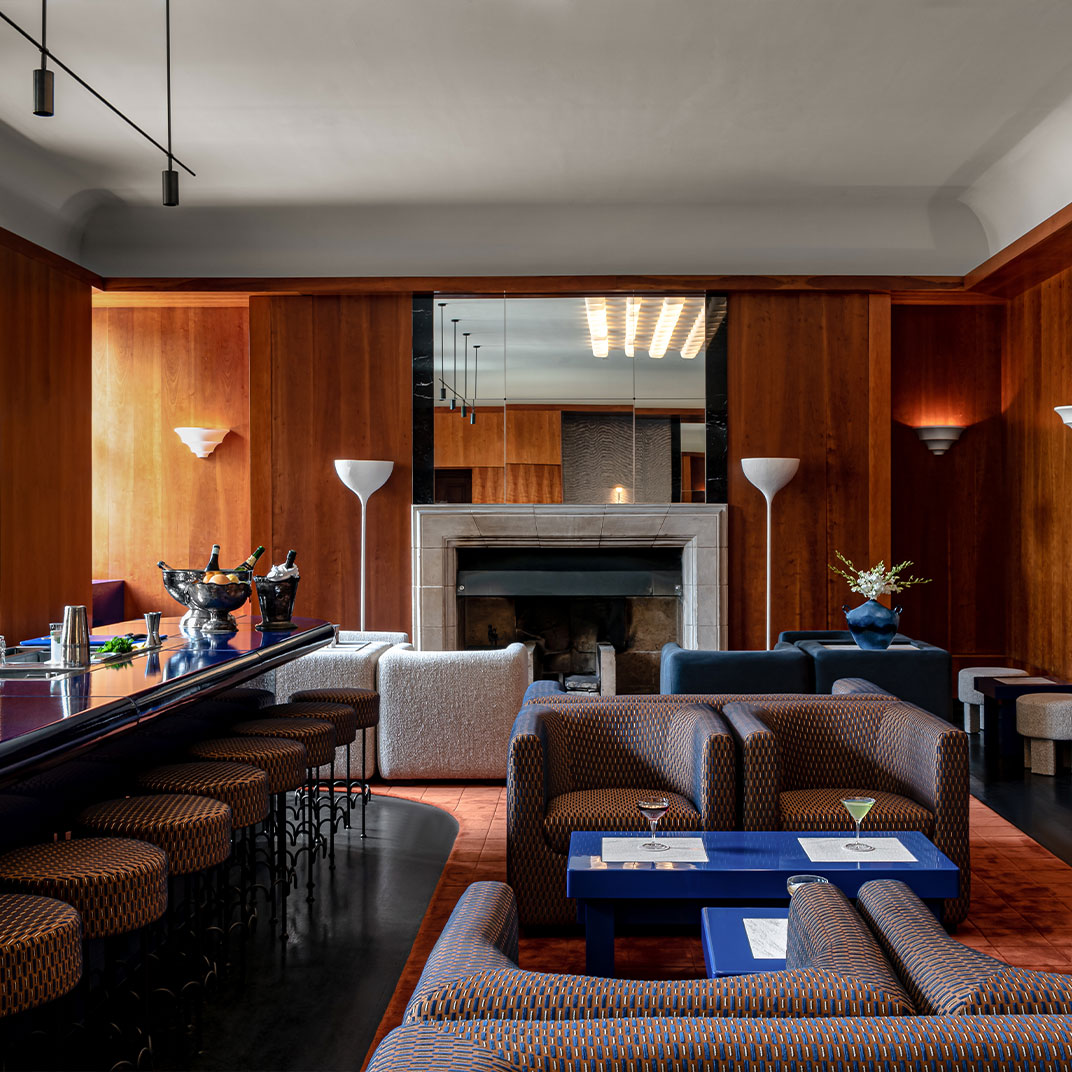THROUGH THE FAWN LENS
A Culinary Journey Through Time: The Evolution of the English Kitchen
The English kitchen, once a smoky, utilitarian space relegated to the back of the house, has undergone a remarkable transformation. Today, it's a social hub, a culinary haven, and the heart of many homes. To understand this evolution, we must embark on a historical journey, exploring how the position and function of the kitchen have been shaped by social practices, technological advancements, and changing societal norms.

Image: the kitchen in our Alresford project
MEDIEVAL HEARTH AND HALL (PRE-16TH CENTURY):
In medieval England, the kitchen wasn't a separate room but rather an open-air affair. The heart of the home was the Great Hall, where a central hearth provided warmth for cooking and gathering. Open fires fueled by wood or peat served multiple purposes - roasting meat, boiling pots hung on cranes, and providing rudimentary lighting. This communal space was a far cry from the modern kitchen, with smoke filling the hall and cooking being a messy, social activity. With rudimentary storage facilities and limited hygiene practices, food preservation remained a constant challenge.
THE RISE OF THE DEDICATED KITCHEN (16TH-18TH CENTURIES):
The Tudor period (1485-1603) saw the rise of the dedicated kitchen – a separate room with better ventilation thanks to chimneys and flues. Large hearths continued to be the main source of heat, but specialised tools like cast-iron pots and pans became more common. Wealthier households started incorporating brick ovens for baking bread and pastries. The kitchen remained a place for servants, but the increasing availability of spices and imported ingredients reflected a growing interest in elaborate cooking.
THE AGE OF REFINEMENT AND THE SCULLERY (18TH-19TH CENTURIES):
The Georgian era (1714-1830) witnessed a shift towards refined and elegant living. Kitchens were relegated to the back of houses or even separate buildings known as sculleries. This separation aimed to keep the mess and noise of cooking away from the main living areas. Larger kitchens in grand houses often featured a central table for food preparation, a precursor to the modern kitchen island used by servants. Sculleries, on the other hand, were smaller, utilitarian spaces housing the primary cooking hearth and often cramped working conditions.
THE INDUSTRIAL REVOLUTION AND THE RISE OF CONVENIENCE (19TH CENTURY):
The Industrial Revolution (1760-1840) brought significant social changes and a growing desire for convenience. The invention of the cast-iron stove in the early 19th century revolutionised cooking. These stoves provided more control over cooking temperatures and offered a cleaner alternative to open fires. The Victorian era (1837-1901) saw further innovations like the coal-fired range, which incorporated baking ovens and hot water boilers, making kitchens more efficient and versatile. However, the size and position of kitchens remained largely unchanged in smaller homes, often cramped and poorly ventilated.
THE DAWN OF MODERNITY AND THE FITTED KITCHEN (20TH CENTURY):
The 20th century saw a dramatic transformation of the English kitchen. The rise of suburbs and smaller living spaces necessitated more efficient kitchen design. The invention of the gas cooker in the early 20th century further fueled this change, offering a cleaner and more readily controllable cooking experience. The interwar period (1918-1939) witnessed the early versions of the "fitted kitchen" concept, with prefabricated units offering improved storage and countertop space. However, it was the post-war period (1945 onwards) that truly ushered in the modern kitchen. The rise of mass-produced, affordable fitted kitchens with standardised units revolutionised kitchen design. These kitchens emphasised practicality and hygiene, focusing on maximising storage and workspace within compact spaces.
THE KITCHEN AS A SOCIAL HUB (LATE 20TH CENTURY-PRESENT):
The late 20th century witnessed a significant shift in the perception of the kitchen. Social changes spurred by feminism and increased leisure time led to a growing desire for open-plan living. Knocking down walls and integrating the kitchen with the living and dining areas blurred the lines between work and social space. Kitchens became a focal point for family gatherings and entertaining friends. With this transition came the rise of the kitchen island, offering additional work surface, storage, and often seating areas, promoting a more social and interactive cooking experience.
MODERN TRENDS:
Today, the English kitchen continues to evolve, reflecting trends in technology, sustainability, and personalisation. High-tech appliances, sleek designs, and a focus on energy efficiency characterise modern kitchen design. Smart appliances controlled by voice or mobile apps, integrated charging stations, and advanced ventilation systems are becoming increasingly popular. Sustainability is also playing a key role, with homeowners opting for recycled materials in cabinetry and worksurfaces. They are also placing an emphasis on well-made, high-quality cabinetry that lasts for decades rather than throwing it out after ten years of use.
THE FUTURE KITCHEN: A GLIMPSE INTO ENGLISH CULINARY SPACES
The English kitchen's journey is far from over. As technology advances, social norms evolve, and environmental concerns take centre stage, we can expect to see some exciting transformations in the years to come. Here's a peek into what the future English kitchen might hold:
SUSTAINABLE SOLUTIONS:
Eco-friendly materials: Expect a surge in the use of recycled materials like bamboo or sustainably sourced wood for cabinetry and worksurfaces. Worksurfaces made from recycled glass or composite materials with a high recycled content will also be popular choices.
Energy efficiency: Appliances will prioritise energy efficiency, with features like automatic shut-off and smart controls that optimise power usage. Integrated downdraft vents could become more discreet and energy-saving compared to traditional extractor hoods.
Waste reduction: Built-in composting bins and food waste disposal systems might become commonplace, encouraging responsible waste management practices in the kitchen.
TECH-SAVVY KITCHENS:
Smart appliances: Voice-activated controls for ovens, refrigerators that automatically generate grocery lists based on expiring items, and self-cleaning appliances are just a few possibilities.
Interactive recipe displays: Imagine a future where worksurface surfaces double as interactive screens displaying recipes and step-by-step cooking instructions.
Personalised cooking experiences: Smart refrigerators and ovens could learn individual preferences and suggest recipes or automatically adjust cooking settings based on dietary needs and past choices.
A SPACE FOR WELLBEING:
Integrated wellness features: Built-in smoothie blenders, dedicated areas for prepping healthy meals, and even smart refrigerators that track nutritional content could become commonplace, reflecting a growing focus on healthy living.
Herb gardens and vertical farming systems: Integrating small vertical gardens or built-in herb stations directly into the kitchen walls or islands will not only enhance aesthetics but also provide fresh ingredients readily available for home cooks.
THE EVOLVING SOCIAL HUB:
Multifunctional islands: Islands with movable sections or hidden extensions might become popular, allowing homeowners to adjust the size and functionality based on their needs. Imagine an island that transforms into a bar area for entertaining or a workspace for online cooking classes.
Virtual connections: The kitchen could become a hub for virtual social gatherings. Imagine video call screens integrated into the island, allowing families and friends to share meals and recipes while cooking together virtually.
Entertainment integrations: Islands equipped with integrated sound systems or hidden projector screens could transform the kitchen into a space for hosting movie nights or game nights with loved ones.
A LOOK BEYOND FUNCTIONALITY:
The future of the English kitchen goes beyond just aesthetics and functionality. It's poised to become an even more personalised space, reflecting the unique needs and personalities of its users.
Bespoke design: With a growing emphasis on customisation, homeowners might opt for bespoke kitchens designed to perfectly fit their space and cater to their specific needs. Imagine a dedicated baking station with a built-in mixer lift for the baking enthusiast or a hidden cocktail bar seamlessly integrated into the island for the entertainer.
Biophilic design: The trend of incorporating natural elements into the home will likely extend to kitchens. Expect to see kitchens with natural light features, a focus on ventilation and air quality, and the use of natural materials like wood and stone, complemented by pops of greenery through integrated planters or herb stations.
Smart lighting: LED lighting systems with adjustable colour temperatures will allow for creating different moods and ambiences in the kitchen, promoting relaxation or focus depending on the activity.
The English kitchen has come a long way from its smoky, utilitarian beginnings. Today, it's a multi-faceted space that reflects our evolving relationship with food, technology, and social interaction. As we move forward, the kitchen will likely continue to adapt, becoming a central hub not just for cooking but also for fostering connections, promoting wellbeing, and embracing a more sustainable future.



